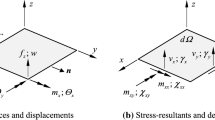Abstract
The classical two-dimensional solution provided by Lévy for the stress distribution in an elastic wedge, loaded by a uniform pressure on one face, becomes infinite when the opening angle 2α of the wedge satisfies the equation tan 2α✱ = 2α✱. Such pathological behavior prompted the investigation in this paper of the stresses and displacements that are induced by tractions of O(r −ω) as r→0. The key point is to choose an Airy stress function which generates stresses capable of accommodating unrestricted loading. Fortunately conditions can be derived which pre-determine the form of the necessary Airy stress function. The results show that inhomogeneous boundary conditions can induce stresses of O(r −ω), O(r −ω ln r), or O(r −ω ln2 r) as r→0, depending on which conditions are satisfied. The stress function used by Williams is sufficient only if the induced stress and displacement behavior is of the power type. The wedge loaded by uniform antisymmetric shear tractions is shown in this paper to exhibit stresses of O(ln r) as r→0 for the half-plane or crack geometry. At the critical opening angle 2α✱, uniform antisymmetric normal and symmetric shear tractions also induce the above type of stress singularity. No anticipating such stresses, Lévy used an insufficiently general Airy stress function that led to the observed pathological behavior at 2α✱.
Similar content being viewed by others
References
Williams, M. L., Stress singularities resulting from various boundary conditions in angular corners of plantes in extension. J. appl. Mech. 19 (1952) pp. 526–528.
Knein, M., Zur theorie des druckversuchs. Z. angew. Math. Mech. 6 (1926) pp. 414–416.
Dempsey, J. P. and G. B.Sinclair, On the stress singularities in the plane elasticity of the composite wedge. Journal of Elasticity 9 (1979) pp. 373–391.
Klingbeil, W. W. and R. T.Shield, On a class of solutions in plane finite elasticity. Z. angew. Math. Phys. 17 (1966) pp. 489–511.
Timoshenko, S. P. and J. N. Goodier, Theory of Elasticity, McGraw-Hill, Inc., 3rd Ed. 1970, p. 141.
Sternberg, E. and W. T.Koiter, Discussion of the wedge under a concentrated couple: a paradox in the two-dimensional theory of elasticity. J. appl. Mech. 26 (1959) pp. 472–474.
Dean, W. R. and P. E.Montagnon, On the steady motion of viscous liquid in a corner. Proc. Camb. Phil. Soc. 45 (1949) pp. 389–394.
Moffatt, H. K., Viscous and resistive eddies near a sharp corner. J. Fluid Mech. 18 (1964) pp. 1–18.
Fenner, R. T., On local solutions to non-Newtonian slow viscous flows. Int. J. Non-linear Mechanics 10 (1975) pp. 207–214.
Dempsey, J. P., Stress singularities of the composite wedge, Ph.D. Dissertation, University of Auckland, New Zealand, 1978.
Author information
Authors and Affiliations
Rights and permissions
About this article
Cite this article
Dempsey, J.P. The wedge subjected to tractions: a paradox resolved. J Elasticity 11, 1–10 (1981). https://doi.org/10.1007/BF00042478
Received:
Issue Date:
DOI: https://doi.org/10.1007/BF00042478




